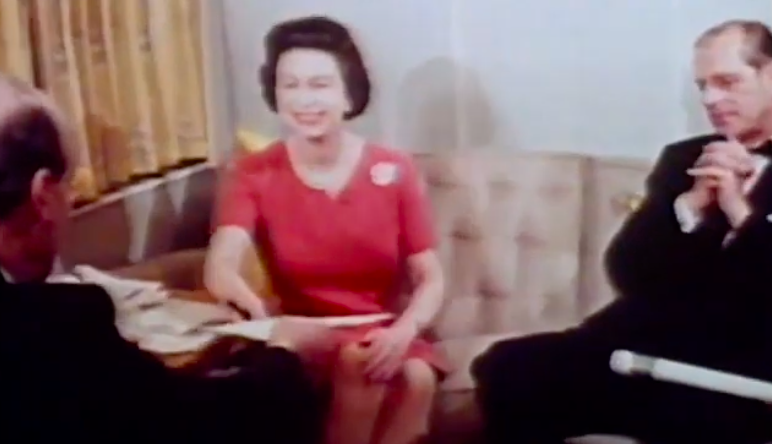
The Queen jokingly called the United States of America’s Ambassador to the United Kingdom a ‘gorilla’ in the banned 1969 documentary ‘Royal Family’.
The footage, which has been locked in the BBC vaults on Her Majesty’s command has mysteriously reemerged this week, having been uploaded to YouTube.
In total, the film is 90 minutes long and is entirely innocuous, with perhaps the exception of an anecdote The Queen shared with her family over dinner.
In the documentary, Her Majesty was seen telling her family how difficult it can be to keep a straight face during some of her engagements.
She said: “It’s extremely difficult to keep a straight face when the Home Secretary said to me: “There’s a gorilla coming in”.”
Her Majesty added: ‘So I said: “What an extraordinary remark to make about someone – very unkind”. I stood in the middle of the room and pressed the bell and the doors opened and there was a gorilla.He had a short body and long arms.
The Home Secretary in 1969 was future Prime Minister James Callaghan, and the US Ambassador to the UK was Walter Annenberg. It is impossible to know, however, whether Her Majesty was talking about these two men.
At the time of broadcast, the film was considered to be a sensational documentary. At the time it was considered intrusive, but now it probably wouldn’t be regarded so, by today’s standards. For example, at the time of broadcast, people were horrified to find out that The Queen stored food in Tupperware containers (something that would be regarded now as a totally legitimate attempt to make the best use of food, horrified staunch conservatives at the time).
But this documentary, which was watched by a third of the UK’s population at the time of its broadcast, had many traditionalists and courtiers up in arms.
The premise of the documentary was for the public to get an idea of what life in the modern royal court of 1969 was like. Cameras followed the Royal Family around for a whole year. 1969 happened to be the year that Prince Charles was invested as Prince of Wales also, this wasn’t a coincidence; cameras were also following the Royal Family’s preparations for the investiture.
Camera crews (in a joint project between the BBC and ITV) accompanied The Queen on tours of Chile and Brazil, and Prince Charles to Malta and Cambridge. They also shot more than 40 hours of film in Sandringham, Balmoral, Buckingham Palace, Windsor and Holyrood, as well as on the Royal Yacht, the Royal Train and aircraft of the Queens Flight.
At the time of broadcast, the film was considered to be a sensational documentary. At the time it was considered intrusive, but now it probably wouldn’t be regarded so, by today’s standards. For example, at the time of broadcast, people were horrified to find out that The Queen stored food in Tupperware containers (something that would be regarded now as a totally legitimate attempt to make the best use of food, horrified staunch conservatives at the time).
But this documentary, which was watched by a third of the UK’s population at the time of its broadcast, had many traditionalists and courtiers up in arms.
The premise of the documentary was for the public to get an idea of what life in the modern royal court of 1969 was like. Cameras followed the Royal Family around for a whole year. 1969 happened to be the year that Prince Charles was invested as Prince of Wales also, this wasn’t a coincidence; cameras were also following the Royal Family’s preparations for the investiture.
Camera crews (in a joint project between the BBC and ITV) accompanied The Queen on tours of Chile and Brazil, and Prince Charles to Malta and Cambridge. They also shot more than 40 hours of film in Sandringham, Balmoral, Buckingham Palace, Windsor and Holyrood, as well as on the Royal Yacht, the Royal Train and aircraft of the Queens Flight.
The Queen was filmed performing official duties such as receiving the new American ambassador and at her regular meeting with Prime Minister Harold Wilson. She was also shown holidaying at Sandringham and enjoying Christmas with her family. Producer Richard Cawston said “until we made this film, I really believe that none of them had ever spoken into a microphone anything which had not been carefully prepared.”

